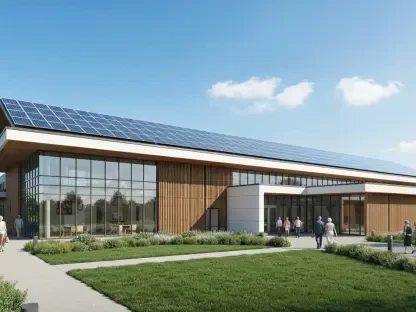The rapidly evolving landscape of urban development has opened new possibilities for renewal and regeneration projects across major cities. In Birmingham, a landmark investment initiative has set a significant precedent in urban revitalization efforts by leveraging public-private partnerships. The endeavor in question is the Stone Yard project, a collaborative venture aimed at transforming the culturally rich area of Digbeth into a thriving rental community. With significant investment funds and cooperation between entities like Aviva Capital Partners, Moda Group, NatWest, Homes England, and the West Midlands Combined Authority (WMCA), the project embarks on an ambitious path to redefine housing solutions and community integration. This initiative highlights the potential of collaborative efforts in addressing complex urban challenges.
Strategic Partnerships and Funding
The Role of Public and Private Entities
The collaboration for Stone Yard illustrates the successful integration of efforts between public and private sectors, underlining the transformative power of these partnerships for urban spaces. Aviva Capital Partners and Moda Group are central figures leading this charge, alongside strategic contributions from NatWest and Homes England. Supported by a substantial financial framework of over £200 million, these stakeholders have each played a vital role in ensuring the project’s feasibility. This financing package includes debt funding facilitated by NatWest and Homes England through the Home Building Fund, showcasing how financial institutions are critical in amplifying these initiatives.
Furthermore, the WMCA’s provision of brownfield grant funding demonstrates a governmental commitment to advancing affordable housing. The project’s provision of affordable housing, set at a Discounted Market Rent, extends the project’s reach to cater to a broader demographic segment, making urban living more inclusive. Hence, this atmosphere of cooperative engagement is a testament to the significant impact joint ventures can have on comprehensive and sustainable development.
Pioneering Financial Framework
The financial framework supporting Stone Yard is a testament to innovative financing solutions required to advance large-scale urban renewal projects. NatWest’s role in extending debt financing introduces an aspect of financial creativity that focuses on long-term solutions for housing infrastructure. Homes England’s involvement through the Home Building Fund further emphasizes the role of national institutions in spearheading strategic housing development. This combination of public and private financing models effectively blends resources to pave the way for future regeneration projects.
Such financial mechanisms are not just about capital injection but are strategic in mobilizing funds where they will have maximum impact. By connecting governmental objectives with private sector efficiencies, projects like Stone Yard can address housing shortages and enhance community welfare. This synthesis of financial and strategic expertise is pivotal in shifting the focus of urban renewal towards more integrated, inclusive spaces that prioritize both economic viability and social responsibilities.
Community-Centric Development
Building a Sustainable Urban Landscape
The Stone Yard project marks a cornerstone in embracing sustainability and community well-being within urban development frameworks. By aiming for certifications from notable accreditors such as Fitwel, Home Quality Mark, and BREEAM, the initiative underscores its commitment to social and environmental sustainability. Such accreditations assure not only the quality of facilities but also adherence to responsible building practices that promote environmental stewardship. This focus on sustainability ensures that the development is future-ready, aligning with global trends towards greener urban environments.
Beyond environmental initiatives, the development aims to enrich resident experiences by integrating diverse amenities designed to foster a strong community sense. Co-working spaces, 24/7 fitness facilities, lounges, and studio spaces cater to a broad range of lifestyle needs, promoting a holistic living experience. These amenities highlight a shift towards a more inclusive living model where personal, professional, and social needs converge in one cohesive environment, enhancing the overall quality of urban living.
Fostering Inclusivity
Inclusivity forms a significant pillar of the Stone Yard project, particularly in its strategic provision of affordable housing. This aspect of the development aims to mirror the socio-economic diversity of Birmingham, ensuring that the benefits of urban regeneration are extended to all residents, regardless of their economic status. By dedicating 20% of housing to affordable living options, the project ensures that a wider demographic can access high-quality accommodations, facilitating community integration.
This inclusive approach is critical in promoting social cohesion within the area, counteracting potential gentrification issues that often accompany substantial urban renewal projects. The strategic distribution of affordable housing throughout the development, rather than isolating it within specific buildings, helps prevent socio-economic segregation. Offering discounted rental options aligns with broader efforts to create a balanced urban community where diverse groups can thrive together, ultimately fostering a harmonious and vibrant neighborhood atmosphere.
Impact and Future Directions
Progressing Urban Renewal Agendas
The Stone Yard initiative is emblematic of current trends in urban renewal, where integrated community-focused developments serve as key components in city planning strategies. Located in Digbeth, a culturally significant area within Birmingham’s creative quarter, the development capitalizes on its prime location to introduce high-quality homes alongside commercial and recreational spaces. By anchoring the project on a four-acre brownfield site along Deritend Road, the initiative not only revitalizes underutilized areas but also leverages the proximity to landmark locations and impending infrastructure developments like the Eastside Metro extension.
Such integrative developments set a paradigm for other cities looking to blend residential, commercial, and social spaces. By adopting a cohesive approach that marries infrastructure with innovation, Stone Yard represents a pivotal step towards crafting urban environments where businesses thrive, communities flourish, and the cultural ethos of the city is preserved. This narrative of renewal and innovation is essential for fostering urban landscapes that support dynamic growth and progressive living conditions.
Aligning Visions and Investments
The Stone Yard collaboration exemplifies the fruitful integration of efforts between public and private sectors, underscoring the transformative potential of such partnerships in urban development. Key players include Aviva Capital Partners and Moda Group, along with strategic support from NatWest and Homes England. Backed by a robust financial structure exceeding £200 million, these stakeholders have each contributed significantly to the project’s viability. The financing, which encompasses debt funding by NatWest and Homes England via the Home Building Fund, highlights the crucial role of financial institutions in enhancing such ventures.
Moreover, the WMCA has provided brownfield grant funding, demonstrating government dedication to expanding affordable housing options. The project, set at a Discounted Market Rent, aims to offer affordable housing to a wider demographic, thereby promoting inclusivity in urban living. This atmosphere of cooperative endeavor highlights the substantial impact that such joint ventures can have on achieving comprehensive and sustainable urban development.









